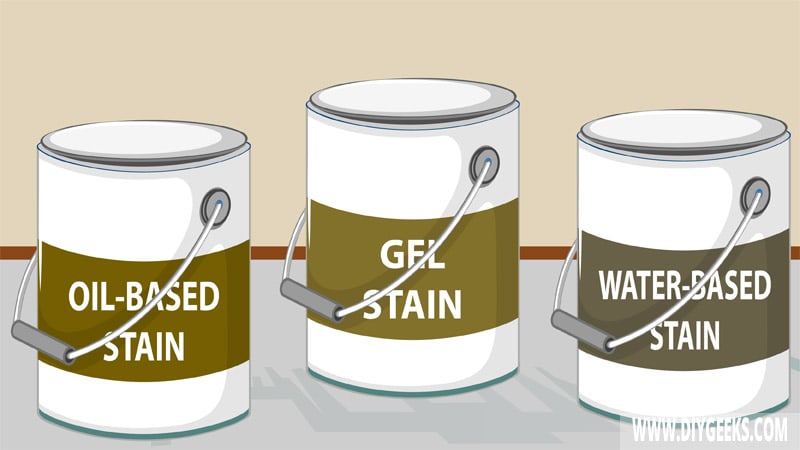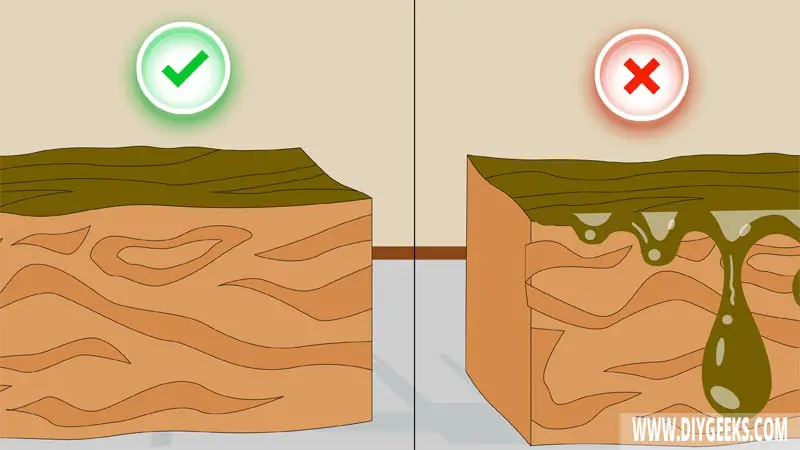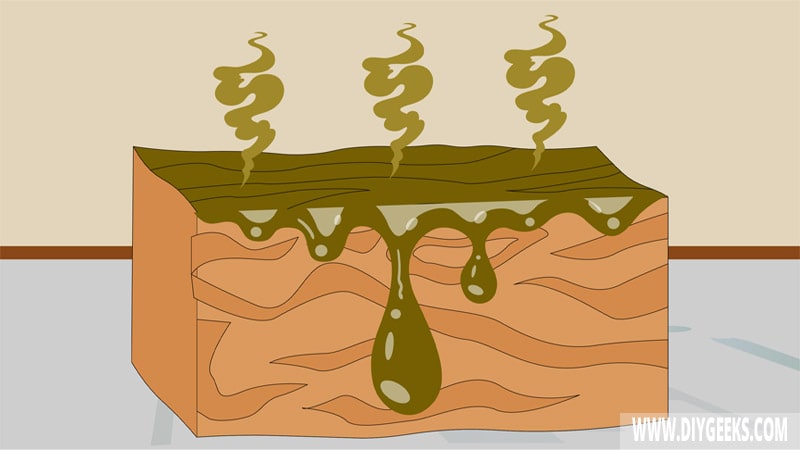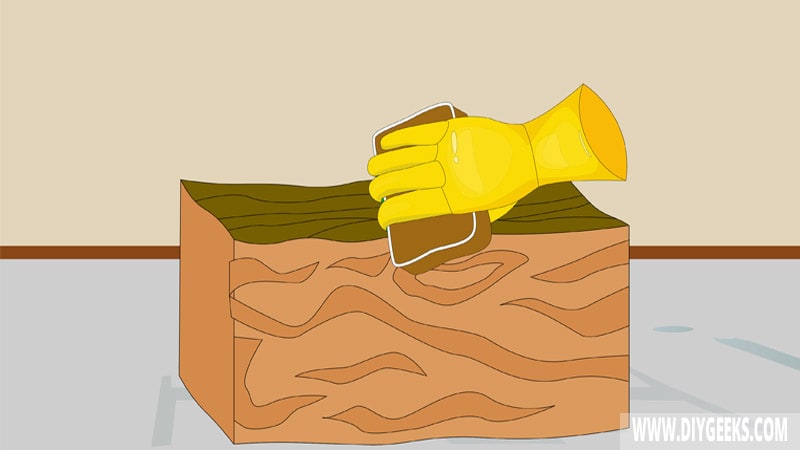Wood stain enhances the wood color, highlights the grain, and preserves it, but it doesn’t protect it from moisture or outdoor elements. You must seal it with polyurethane to improve the durability of the finish.
Water-based wood stain must dry fully for around 24 hours, oil-based wood stain for 48-72 hours, and gel stain for 48 hours before polyurethane.
The finish will turn sticky and might peel off if you apply polyurethane too soon. To speed up the wood stain drying time, apply thin coats or increase the evaporation rate.
How Long Does Wood Stain Take To Dry?

Water-based wood stain takes less than 30 minutes to dry between coats and around 24 hours to cure. Oil-based wood stain takes around 1 hour to dry between coats and around 48-72 hours to cure.
The exact dry time of wood stain depends on the type of stain, thickness and number of the coat, room temperature, and humidity levels.
A coating takes longer to dry if the humidity levels are high because the evaporation rate is slower.
Water-based wood stain dries faster than oil-based stain because it uses water as its solvent and water evaporates faster than oil.
Gel Stain
Water-based gel stain takes around 12 hours to dry, while oil-based gel stain takes 24 hours.
Wait 48 hours before applying polyurethane over Gel stain. This gives the coating enough time to cure and compact for a topcoat.
Gel stain takes longer to dry because it has a thicker flow, and the oil-based type contains too many oils. Since the flow is thicker and has too much oil, the evaporation rate is slower.
It’s advised to thin it before applying it to speed up the drying time.
Water-Based Wood Stain
Water-based stain takes around 30 minutes to dry to touch, less than 1 hour to re-coat, and 24 hours to cure. It dries faster because it uses water as its solvent, and water evaporates fast.
Oil-Based Wood Stain
Oil-based stain takes around 1 hour to dry between coats and 48-72 hours to cure. It takes oil-based stain longer to dry because it has a thick flow and uses oil as its solvent.
How To Know if a Wood Stain Coating is Dry Enough?

To know if a wood stain coating is dry enough, inspect the texture of its finish. Its finish must be hard, strong, and dry.
Swipe your fingers across the coating; if the coating is sticky or well, the finish hasn’t dried yet. If the finish feels dry and smooth, it’s dry enough.
You can also swipe a fine-grit sandpaper (400 grit) over the wood stain coating to know if it’s dry. The coating is dry enough for polyurethane if the sandpaper moves freely (or smoothly) over it. The coating isn’t dry enough if the finish clogs the sandpaper (doesn’t move freely).
What Happens If You Apply Polyurethane Before Stain Dries?

The finish will turn sticky and might peel off if you apply polyurethane before stain dries. To fix it, you must remove both finishes, dry the surface, and re-apply them.
Wood stain dries through evaporation of the solvent, so if you apply polyurethane before the existing coating dries, the solvent can’t evaporate. The existing coating will remain wet, won’t dry, and will turn sticky if the solvent can’t evaporate.
Wood stain must fully dry (cure) before sealing it. Its coating fully dries (cures) once the solvent evaporates and the particles harden and compact. The coating won’t be hard or compact enough to support a topcoat if you seal it too soon.
Related Read: Can You Apply Polyurethane Over Tacky Stain?
Do You Need To Sand Wood Stain Before Applying Polyurethane?

You don’t need to sand wood stain before applying polyurethane as it will stick regardless. Polyurethane is a topical finish and sticks over surfaces without having to penetrate them.
You must sand only if the wood stain finish is dirty, has imperfections, or bumps. Sanding with fine-grit sandpaper will remove imperfections and dirt, and even out the surface without removing the existing finish.
Polyurethane is a clear coat (has no color) and will show (highlight) imperfections on the surface. So, it’s important to sand off the surface before applying polyurethane as it won’t hide them.
You must sand if the wood stain has been previously sealed (the top coat is still on the surface). An existing top coat (sealer) will prevent polyurethane from sticking properly. So, you must sand off the sealer with medium-grit sandpaper.
Do You Need To Apply An Undercoat Between Stain and Polyurethane?
You don’t need to apply an undercoat between stain and polyurethane. An undercoat, such as primer or wood conditioner, will cover the wood stain color and the highlighted grain, so it defeats the purpose of staining wood.
Polyurethane has a transparent finish, so the finish color isn’t affected. If you seal a stained wood, the wood grain and the finish color will still show once the polyurethane dries. An undercoat (primer or wood conditioner) will cover the finish.
You must apply an undercoat only if the stained wood is damaged, uneven, or has imperfections and holes. The undercoat will cover the imperfections and the holes, but it will also cover the grain of the wood.
As an alternative, you can apply more coats of wood stain to cover imperfections or sand the surface with medium-grit sandpaper.
Related Read: Can You Apply Polyurethane Over Gel Stain?
How To Speed Up Wood Stain Drying Time?
To speed up wood stain drying time, apply thin coats or increase the evaporation rate.
Thin coats dry faster as there’s less solvent on the surface, so it evaporates faster. To increase the evaporation rate, increase the heat around the coating using a hairdryer (for 5 minutes only).
But, it’s best to leave the wood stain dry naturally as the finish will become stronger and more durable.
Water vs. Oil-Based Polyurethane
You can use either water-based or oil-based polyurethane on a wood stain. Both will stick over stained wood and protect it from moisture, water, scratches, or other damage. However, water-based polyurethane will dry faster, but oil-based polyurethane will protect the wood better.
For outdoor stained wood, use exterior polyurethane.
How Long Does Polyurethane Take to Dry?
It takes oil-based polyurethane around 48-72 hours to dry fully (cure) over stained wood, while water-based poly cures within 24 hours.


